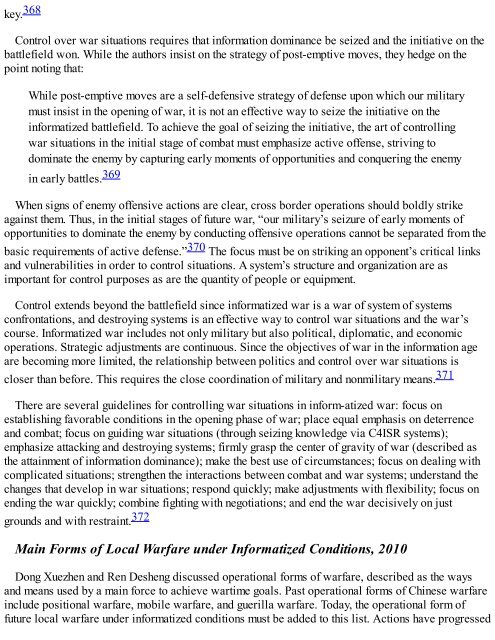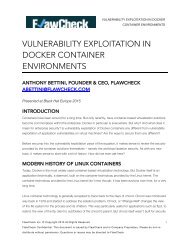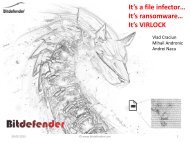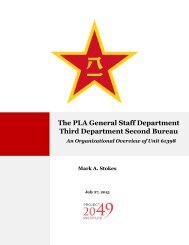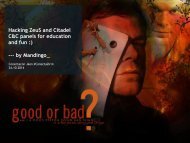3Faces%20of%20the%20Dragon
3Faces%20of%20the%20Dragon
3Faces%20of%20the%20Dragon
Create successful ePaper yourself
Turn your PDF publications into a flip-book with our unique Google optimized e-Paper software.
key. 368<br />
Control over war situations requires that information dominance be seized and the initiative on the<br />
battlefield won. While the authors insist on the strategy of post-emptive moves, they hedge on the<br />
point noting that:<br />
While post-emptive moves are a self-defensive strategy of defense upon which our military<br />
must insist in the opening of war, it is not an effective way to seize the initiative on the<br />
informatized battlefield. To achieve the goal of seizing the initiative, the art of controlling<br />
war situations in the initial stage of combat must emphasize active offense, striving to<br />
dominate the enemy by capturing early moments of opportunities and conquering the enemy<br />
in early battles. 369<br />
When signs of enemy offensive actions are clear, cross border operations should boldly strike<br />
against them. Thus, in the initial stages of future war, “our military’s seizure of early moments of<br />
opportunities to dominate the enemy by conducting offensive operations cannot be separated from the<br />
basic requirements of active defense.” 370 The focus must be on striking an opponent’s critical links<br />
and vulnerabilities in order to control situations. A system’s structure and organization are as<br />
important for control purposes as are the quantity of people or equipment.<br />
Control extends beyond the battlefield since informatized war is a war of system of systems<br />
confrontations, and destroying systems is an effective way to control war situations and the war’s<br />
course. Informatized war includes not only military but also political, diplomatic, and economic<br />
operations. Strategic adjustments are continuous. Since the objectives of war in the information age<br />
are becoming more limited, the relationship between politics and control over war situations is<br />
closer than before. This requires the close coordination of military and nonmilitary means. 371<br />
There are several guidelines for controlling war situations in inform-atized war: focus on<br />
establishing favorable conditions in the opening phase of war; place equal emphasis on deterrence<br />
and combat; focus on guiding war situations (through seizing knowledge via C4ISR systems);<br />
emphasize attacking and destroying systems; firmly grasp the center of gravity of war (described as<br />
the attainment of information dominance); make the best use of circumstances; focus on dealing with<br />
complicated situations; strengthen the interactions between combat and war systems; understand the<br />
changes that develop in war situations; respond quickly; make adjustments with flexibility; focus on<br />
ending the war quickly; combine fighting with negotiations; and end the war decisively on just<br />
grounds and with restraint. 372<br />
Main Forms of Local Warfare under Informatized Conditions, 2010<br />
Dong Xuezhen and Ren Desheng discussed operational forms of warfare, described as the ways<br />
and means used by a main force to achieve wartime goals. Past operational forms of Chinese warfare<br />
include positional warfare, mobile warfare, and guerilla warfare. Today, the operational form of<br />
future local warfare under informatized conditions must be added to this list. Actions have progressed


